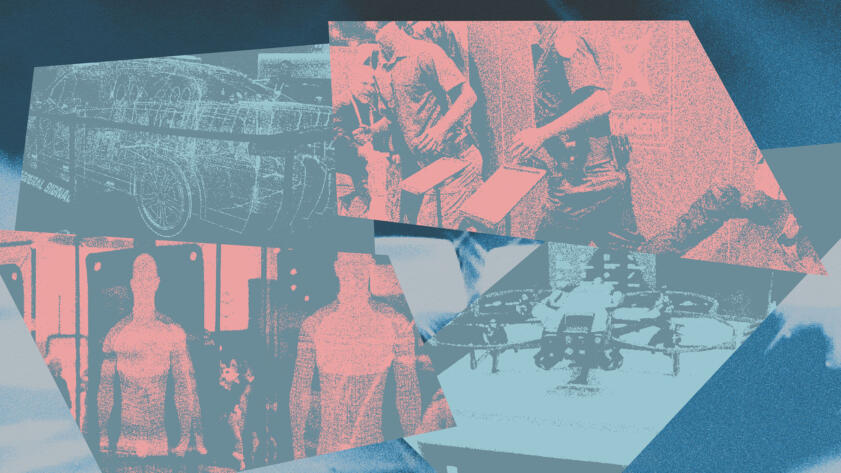Subscribe to Hello World
Hello World is a weekly newsletter—delivered every Saturday morning—that goes deep into our original reporting and the questions we put to big thinkers in the field. Browse the archive here.
There’s a particularly cheeky episode of Brooklyn 99 about a fictitious Tri-State Police Officers Convention, an annual conference that brings police officers—including the show’s ensemble—together for presentations, professional development, and parties.
“Cop-Con” is a ride: Despite their captain urging them to be on their best behavior, members of the squad spend their time at the conference scheming on a wild party with their colleagues at other agencies. There are hijinks, of course: A laptop is stolen, then sabotaged; a police robot is pushed off a balcony; someone throws up in a pillowcase.
Surprisingly, the antics weren’t the most fascinating part of the episode for me, but rather the impressive tech expo hall full of vendors demonstrating new police gadgetry. The cast plays with some of these tools, like police robots equipped with cameras, electroshock weapons, and devices that generate painful sounds only those under 35 can hear.
The show’s fictional expo hall bears a striking resemblance to the one I walked through at the International Association of Chiefs of Police (IACP) conference, in San Diego last month. It is so similar that when I recently watched the episode, I did so like this, at the edge of my seat:
Unlike the conference in Brooklyn 99, which was regional, the IACP conference had a global reach: Around 16,000 attendees packed the San Diego Convention Center, including delegations from countries including Indonesia, Ireland, the Dominican Republic, the United Kingdom, Brazil, the Ivory Coast, Kazakhstan, Haiti, Nigeria, the Bahamas, Saudi Arabia, Japan, Canada, and Jamaica.
After walking thousands of steps around the expo floor over several days, where nearly 700 vendors were demonstrating and showcasing their latest, I got to see and learn a bit about hundred of new products, including voice analysis algorithms that claim to detect fraud risks based on speech, virtual reality training simulators, robot dogs, window-breaking drones, and tracking devices that looked exactly like packs of Newport cigarettes or bottles of medication.
It took me virtually the entire conference to make it from one end of the expo floor to the other.
Most of the emerging public safety tech I saw falls into three big buckets:
- Robotic tools like drones and police robots that could enter spaces that might be difficult or unsafe to send an officer. One drone I saw could come armed with a tool that allowed it to break a window.
- Emerging and enhanced surveillance technologies like automatic license plate readers, which can capture images of cars and other vehicles that police officers can use to target investigative leads. In some cities, I learned, this kind of technology generates a million or more images a day.
- Artificial intelligence and algorithmic products were, predictably, among the tools I saw the most. In addition to the voice analysis tools I described above, companies advertised tools that aggregate and analyze data (including social media, jail data systems, video feeds, court records, and social media) to generate quick insights.
To give our readers a more robust view of the conference and the police tech trends, I also asked experts who attended or presented workshops at IACP’s conference to share their thoughts about the emerging tools — and about the technology that was noticeably absent at the conference. Read that here.
I want to learn more about what you’re interested in within the public safety technology space. What fascinating tech are police officers in your hometown using that you’d like an investigative reporter to dig into? Have you seen the “Cop Con” episode of Brooklyn 99? Email me about it (seriously!) at ese@themarkup.org, or message me on Signal at 646-504-2673.
‘Til next time,
Ese





